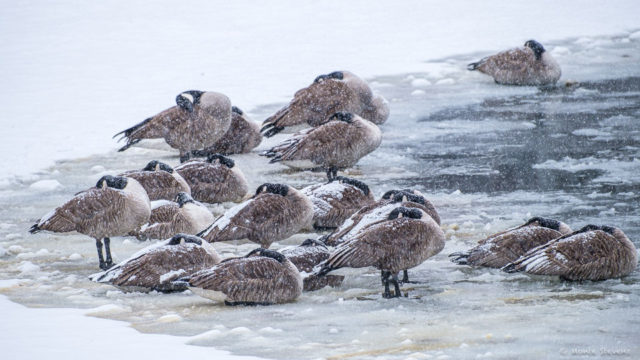Well, since you asked, here are some interesting facts for you about Canada Geese. Geese on the ice may be resting or preparing to move on to un-frozen bodies of water when need be. Huddling their bodies together on the ice of a shallow pond can cause it to warm up, especially along the edges, and increase their food supply, so sleeping on the ice can merely be a step towards thawing it out.
Their bodies are built to stay warm. They have insulated underbellies, and enough feathers, generally between 20,000 and 25,000, to keep their upper body temperature around 104°F (40°C). (Goose down has long been considered the warmest filling for things such as jackets and sleeping bags.)
Geese also have an interesting type of circulation through their feet that transfers warm blood back up into their bodies. Since their feet can’t freeze, they often sleep with them tucked underneath their bodies. This heat-transference phenomenon is one of the reasons why sometimes you’ll see them standing on one foot with the other tucked up under the belly, especially when the ground is frozen. 1Courtesy of Google.

6 Comments
Faye
Interesting facts and a super image to accompany. I feel cold just looking at them, plus I’m allergic to down feathers so I would make a lousy goose.
Monte Stevens
I’ve acquired a few allergies as I’ve gotten older. I get the allegic biggest reaction when I’m around anyone who is working. 😂
Tom Dills
I need to figure out how to do that heat transfer thing to my feet! My wool socks can only do so much! Thanks for the goosal biology lesson! 😉
Monte Stevens
I’m the same. Smartwool are good but….
Mark
Now if we could only do the same! 🙂 Thanks for the lesson Monte, I didn’t know this.
Monte Stevens
I would imagine the insulation and circulation decreases with age just as it does for us. I know you are always posting something for me to learn. Have a great day!